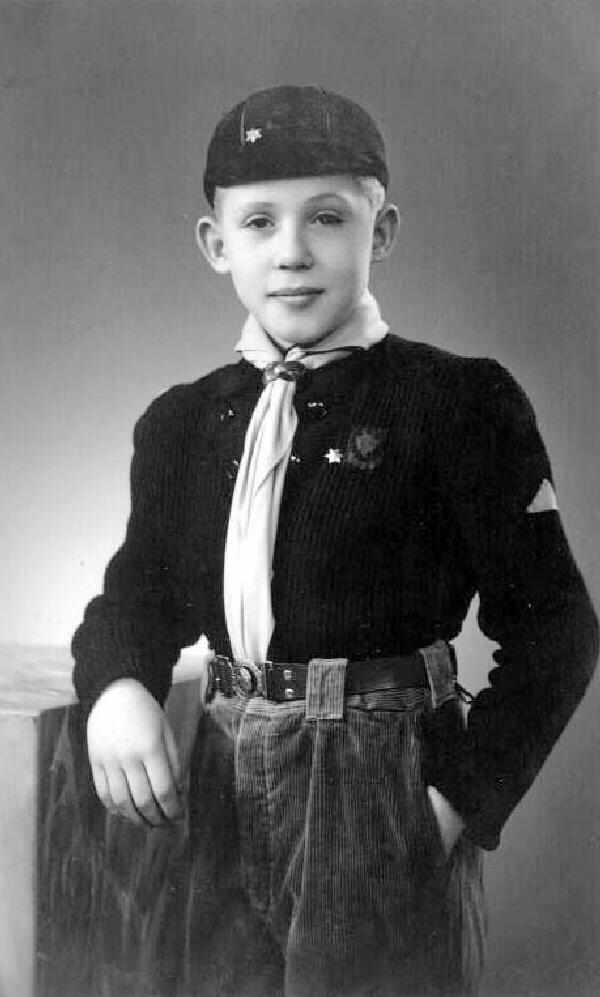
Figure 1.-- This Belgian Cub Scout had his portriat taken in 1954. We are not sure, however, to which association he belonged. Notice the cord rather than matching shorts. |

|
We do not yet have detailed information on the levels of Belgian Scouting. This is complicated somewhat by the fact that are several different associations and they did not coordinate their uniforms. We do not know at this time if the different assovitions have different names for the different levels of Scouting are for that matter different level structures. We note Cubs and Scouts in the different associations, although we are not yet sure of thee precise French/Dutch (Flemish) language terms. Cubs were usually called Louveteaux in French speaking groupps. This Flemish Cub Scout had his portriat taken in 1954. We are not sure, however, to which association he belonged. Notice the cord shorts (figure 1). I'm not sure about the colors. It looks to us like it might be blue and we note color photographs of some Belgian Cubs wearing blue uniforms. Mot assicuaitioins began with the Scouting group and then added Cubbing and other programs. The Belgian associations varied in size. Belgium itself is a relatively small country. As a result, a relatively small number of boys and eventually girls were involved in the program. This affected the ability of dividing the members of in age level groups. Not all of the Belgian Scouting associations have all of the different Scouting levels and the age rangs emay vary slightly. Aftter World War II in the post=War era the varius boy and girl groups began to join into coed groups. Guidisme Et Scoutisme En Belgique-Gidsen En Scouts In Belgie (GSB) -(Guiding and Scoutng in Belgium) is a Federation of four Associations. Scouting in Belgium started in 1908 but the Federation was not formed until 1937. The Federation co-ordinates all the four Associations' work on Extension Scouting and their co-operation with the Guides. The GSB has coordinated manybaspects such as the age levels.
Beavers are the youngest age group. They are children ages 6 to 8 years. This was post-War development. They were generally formed as coed groups. We are not sure if there are Beaver groups in Belgium.
The first Scout units formed were the Boy Scouts. This was Naden Powell's concept in Britain. The thing is that younger boys want to join up as well, especially yonger brothers. The first Cub groups were formed in in Britain (1916). European Scouts Associations qyuickly followed suit. We are not sure yet with the Nelgian Scout associations added Cub groups, but we think it was very quickly after the British Scouts founded the Cub program. Belgium was occupied by the Germans at the time so it would have been after the War and the first Allied liberation pf Belgium. Cubs are usually boys ages 8 to 11-12 Years old. French speaking Cubs are commonly called Louveteaux and Jeannette for the girls. The Belgian Cubs were called Welpen. They were boys 7-11 years old. Cubbing became a very popular oart of the Scouting movement in the inter-War era. Uniforms varied. We see some Belgian Cubs wearing blue uniforms. Wevalso nsee green nuniforms like the British Cubs.
The initial Scouring groups were Scout troops and called Scouts. The initial girls groups were Guides. This was the British name for girl scouts. The GSB standard was boys and girls ages 11 to 15 years old, at girst in gender separate groups. Naden Powell conducted his Brown Sea Islkand experiment (1906). Almost immediatdly we see Europoean groups organized. In Belgium the first troop was oranized in Brussels (1909). It was organized by Englishman Harold Parfitt. It was organized for British boys in the city. Belgian boys (such as Henri, son of Antoine Depage) noticing the the British troop's activities and it looked like fun. Soon Belgian troops begab to appear. Boy Scouts of Belgium (BSB), the first Belgian scout association was founded in Brussels (1909). They were so new that they at first used the British badges, rules. and uniforms. This association was open to all boys meaning ethnicity/language and religion. The BSM began working on a compatable Girl Guide troop (1911). The Gernas invaded Belgium launching World War I (1914). The resulting German occupation hampered the movements' development. The Germas saw the Scout movement as a British movement. So the Girl Guides of Belgium were not founded until after the War (1919). They also used British badges, rules and uniforms.
Explorers in French speaking countries were often called Pionniers/Caravellesages. The GSM dsignation is Seniors. They were boys 15 to 18 years old. When the Guides were incoporated, the same age range was maintained.
Rovers in French were called ages Compagnons. The Belgian name was Voortrekkers, a Flemish term. They were youth 18 to 21½ years old. We do not have much information on them.
Navigate the Historic Boys' Uniform Chronology Pages:
[Return to the Main chronologies page]
[The 1900s]
[The 1910s]
[The 1920s]
[The 1930s]
[The 1940s]
[The 1950s]
[The 1960s]
[The 1970s]
[The 1980s]
[The 1990s]
[The 2000s]
Navigate the Historic Boys' Uniform Web Site:
[Introduction]
[Activities]
[Biography]
[Chronologies]
[Countries]
[Essays]
[Garments]
[Organizations]
[Other]
[Bibliographies]
[Contributions]
[FAQs]
[Questions]
[Unknown images]
[Boys' Uniform Home]
Navigate the Historic Boys' Uniform Web organizatiion pages:
[Return to the Main Belgian Scout page]
[Return to the National Scout page]
[Boys' Brigade]
[Boys Club]
[Camp Fire]
[Hitler Youth]
[National]
[Pioneers]
[Royal Rangers]
[Scout]
[YMCA]
